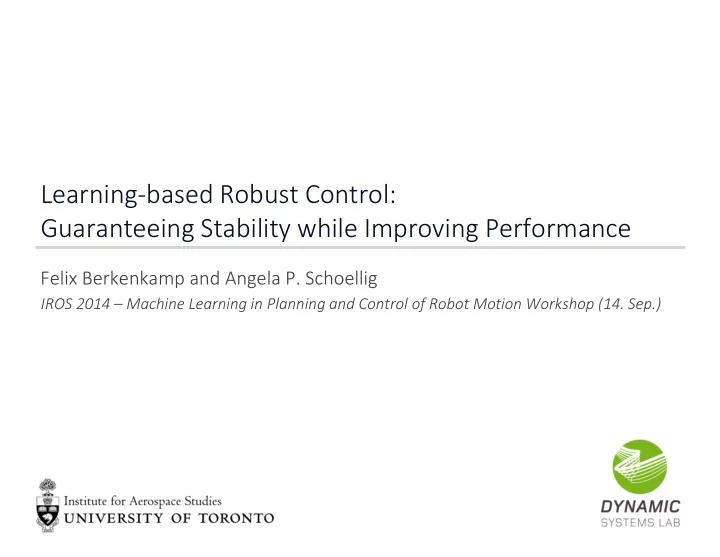

Learning ‐ based Robust Control: Guaranteeing Stability while Improving Performance Felix Berkenkamp and Angela P. Schoellig IROS 2014 – Machine Learning in Planning and Control of Robot Motion Workshop (14. Sep.)
Why is model ‐ based control not always sufficient? • Model inaccuracies limit achievable performance! • Surface Material • Topography • Unknown dynamics Felix Berkenkamp 2
How these problems have been tackled so far Robust Robust control control Onl Online ne le learning • Specify prior uncertainty • Learn from online data in model • Improve the model • Guarantee stability and performance for all possible models Online learning Nominal model Nominal model True model True model Set of possible models Felix Berkenkamp 3
The missing link Nominal model True model Learning- Robust Online based Robust Control learning Control Set of possible models Models uncertainty Online learning Guarantees stability True model Improves Nominal model online Set of possible models S. Schaal and C. G. Atkeson, “Learning control in robotics,” IEEE Robotics & Automation Magazine, vol. 17, no. 2, pp. 20–29, 2010. Felix Berkenkamp 4
Model for our approach • Stabilization of an operating point • Robust Control: Guaranteed stability / performance • Gaussian Process: Online learning Felix Berkenkamp 5
Framework: linear Robust Control • Extended linear plant • Output • Uncertainty • Disturbance • Error signal Goal: Find K such that • Stab ability ility: stable for all allowed • Perform Performance: minimized Convex optimization problem Felix Berkenkamp 6
Gaussian Process (GP) learning • Objective: learn the model error with uncertainties from input/output data • Assumption: Correlation of data given by a kernel function Similar inputs will lead to similar outputs • Hyperparameters (noise and scaling): learned from data Felix Berkenkamp 7
Gaussian Process learning Felix Berkenkamp 8
Gaussian Process in our context • Model: Nominal model • GP inputs: • GP outputs: True model Set of possible models Felix Berkenkamp 9
Example: simple linear/affine system • True model: • Without prior knowledge, use GP to learn system dynamics Felix Berkenkamp 10
Parameters estimated using GP Felix Berkenkamp 11
Bringing GPs and Robust Control together This generalizes to non-linear, non-scalar, MIMO systems using the same process for element- wise uncertainty Felix Berkenkamp 12
The complete process Nominal model True model True model Nominal model Set of possible models Set of possible models 13 Felix Berkenkamp
Experimental results: https://youtu.be/YqhLnCm0KXY?list=PLC12E387419CEAFF2 step response step response step response 0.2 0.2 0.2 800 800 800 0 0 0 1000 1000 1000 -0.2 -0.2 -0.2 desired 2000 2000 x position [m] x position [m] x position [m] 3000 desired -0.4 -0.4 -0.4 desired -0.6 -0.6 -0.6 -0.8 -0.8 -0.8 -1 -1 -1 0 0 0 2 2 2 4 4 4 6 6 6 8 8 8 10 10 10 12 12 12 14 14 14 time [s] time [s] time [s] 0.2 0.2 0.2 800 800 800 0 0 0 1000 1000 1000 -0.2 -0.2 -0.2 2000 desired 2000 y position [m] y position [m] y position [m] 3000 desired -0.4 -0.4 -0.4 desired -0.6 -0.6 -0.6 -0.8 -0.8 -0.8 -1 -1 -1 0 0 0 2 2 2 4 4 4 6 6 6 8 8 8 10 10 10 12 12 12 14 14 14 time [s] time [s] time [s] Felix Berkenkamp 14
Summary • Combined Combined Gaussian Process lear arni ning ng with Linear Robust Robust Cont Control rol • Enables contro controlle ller perform performance to to im improve onlin online while providing stab stability ility guaran guarantees Nominal model True model True model Nominal model Set of possible models Set of possible models Felix Berkenkamp 15
Thank you! Felix Berkenkamp befelix@ethz.ch
Recommend
More recommend